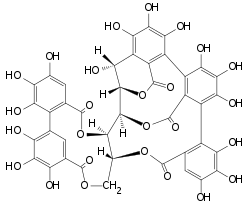
The ellagitannins are a diverse class of hydrolyzable tannins, a type of polyphenol formed primarily from the oxidative linkage of galloyl groups in 1,2,3,4,6-pentagalloyl glucose. Ellagitannins differ from gallotannins, in that their galloyl groups are linked through C-C bonds, whereas the galloyl groups in gallotannins are linked by depside bonds. [1]
Contents
- Examples
- Metabolism
- Degradation
- Natural occurrences
- See also
- Other links
- References
- Further reading
- External links
Ellagitannins contain various numbers of hexahydroxydiphenoyl units, as well as galloyl units and/or sanguisorboyl units bounded to sugar moiety. In order to determine the quantity of every individual unit, the hydrolysis of the extracts with trifluoroacetic acid in methanol/water system is performed. Hexahydroxydiphenic acid, created after hydrolysis, spontaneously lactonized to ellagic acid, and sanguisorbic acid to sanguisorbic acid dilactone, while gallic acid remains intact. [2]
Ellagitannins generally form macrocycles, whereas gallotannins do not.